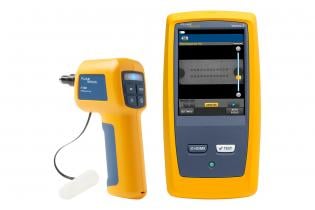Investing in optical fibre testing equipment optimizes network efficiency.
Investing in optical fibre testing equipment optimizes network efficiency.
Blog Article
Discover the Value of Optical Fibre Screening in Modern Telecommunications
In the world of modern telecommunications, the importance of optical fiber screening can not be overemphasized, as it serves as the foundation for making sure network integrity and performance. What are the details advantages that normal testing offers, and how might it shape the future landscape of telecommunications?

Comprehending Optical Fibre Screening
Optical fibre testing is an important procedure in telecommunications that makes sure the stability and efficiency of fiber optic networks. This screening incorporates a series of treatments created to review the physical and useful features of optical fibers - optical fibre testing equipment. Key parameters analyzed consist of optical power loss, bandwidth ability, and mistake place, which are vital for keeping top quality communication links
The testing process commonly includes using specialized tools such as Optical Time-Domain Reflectometers (OTDR) and Optical Power Meters. OTDRs are employed to determine and identify mistakes, entwines, and adapters within the fibre, while power meters determine the transmitted light signal toughness to determine efficiency.
Furthermore, testing is performed at various stages, consisting of during setup, upkeep, and troubleshooting, to guarantee that the network meets industry requirements and operational requirements. Compliance with standards set by companies like the International Telecommunication Union (ITU) and the Telecommunications Sector Organization (TIA) is critical.
Advantages of Routine Evaluating
Regular screening of optical fibres returns many benefits that significantly enhance network reliability and efficiency. One of the primary benefits is the very early discovery of potential problems, such as breaks or destruction in the fibre, which can lead to costly downtime if left unaddressed (optical fibre diameter analyser). By recognizing these issues proactively, telecoms providers can lessen service disruptions and guarantee regular connection for their customers
Additionally, routine screening assists to keep the honesty of signal quality. As optical fibres age, their performance can be affected by variables such as environmental conditions and physical anxiety. Routine assessments allow for the tracking of signal loss and general transmission efficiency, making certain that the network runs at ideal degrees.
Another significant benefit is compliance with market standards. Normal testing sustains adherence to regulative needs, thereby minimizing lawful and monetary threats related to non-compliance. It boosts the general life-span of the fiber facilities by promoting prompt upkeep and fixings.

Usual Checking Methods
Testing optical fibres uses various methods to make sure the stability and performance of telecoms networks. Among one of the most common techniques is Optical Time Domain Name Reflectometry (OTDR), which evaluates the entire length of the fibre by sending out a pulse of light and determining the reflections created by blemishes or breaks. This approach offers comprehensive details concerning the area and extent of faults.
Another widespread technique is using Optical Power Meters, which measure the amount of light sent via the fiber. This technique assists identify the loss of signal toughness, making sure that it satisfies market criteria. In Addition, Visual Mistake Locators (VFL) are used to determine breaks or extreme bends in the fibre by predicting a noticeable laser light right into the cable television.
Insertion loss screening is additionally important, as it quantifies the loss of signal power arising from connections and mates within the network. Moreover, the usage of click site Polarization Mode Diffusion (PMD) testing examines the effect of fiber qualities on signal stability.
Each see this of these techniques plays an essential duty in keeping the performance and dependability of optical fiber networks, eventually contributing to seamless telecoms operations.
Influence On Network Performance
The stability and performance of optical fiber networks straight influence total network performance. In modern-day telecoms, the efficiency of information transmission relies greatly on the quality of the optical fibers made use of. Any kind of destruction in the fibre's condition-- whether as a result of physical damages, contamination, or extreme flexing-- can cause boosted depletion and signal loss, considerably influencing information honesty and rate.
Normal optical fiber screening is crucial to determine and correct prospective concerns before they show up as network failures or slowdowns. Techniques such as Optical Time Domain Reflectometry (OTDR) and insertion loss testing enable specialists to measure the performance of fibre links properly. These tests not just examine the physical condition of the fibres but also guarantee conformity with sector standards, consequently protecting the network's integrity.
In addition, a well-maintained optical fiber network contributes to decreased operational costs and boosted client contentment, as end-users go to my site experience less disturbances and higher information rates. Eventually, the emphasis on rigorous optical fiber testing techniques works as a cornerstone for sustaining durable telecoms facilities, making sure that company can meet the growing needs for transmission capacity and connection in today's digital age.
Future Patterns in Evaluating
As we look ahead, innovations in technology are positioned to reshape optical fibre testing in telecommunications. The rise of automation and man-made knowledge (AI) is expected to improve the performance and precision of screening procedures. Automated testing systems can carry out comprehensive evaluations with marginal human intervention, considerably reducing the possibility for errors and expediting time-to-deployment.
Moreover, the combination of equipment discovering formulas will certainly allow predictive upkeep, enabling network providers to predict potential issues prior to they intensify right into failures. This positive approach not only improves network reliability but additionally maximizes operational costs.
One more emerging fad is the advancement of mobile testing devices that supply real-time analysis - optical fibre testing equipment. These devices will certainly equip professionals to perform on-site diagnostics quickly, facilitating quicker resolutions and boosting service quality
The expansion of 5G networks even more requires the evolution of screening methods. As transmission capacity demands raise, conventional testing techniques may no longer are sufficient. Ingenious solutions such as optical time-domain reflectometry (OTDR) and progressed spectral analysis will end up being vital in guaranteeing the honesty and performance of high-speed connections.

Verdict
To conclude, optical fibre testing is necessary for making certain the integrity and dependability of contemporary telecoms networks. Regular screening methods not just aid determine prospective concerns such as signal loss and mistakes but additionally add to boosted network efficiency and customer contentment. As the demand for smooth connection remains to grow, the adoption of advanced screening approaches will play a crucial duty in maintaining high-grade network standards and sustaining the developing landscape of telecommunications.
Report this page